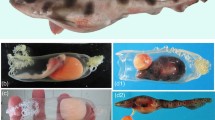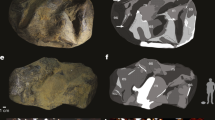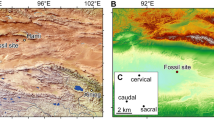Abstract
The extinct placoderm fishes were the dominant group of vertebrates throughout the Middle Palaeozoic era1, yet controversy about their relationships within the gnathostomes (jawed vertebrates) is partly due to different interpretations of their reproductive biology2,3,4,5. Here we document the oldest record of a live-bearing vertebrate in a new ptyctodontid placoderm, Materpiscis attenboroughi gen. et sp. nov., from the Late Devonian Gogo Formation of Australia (approximately 380 million years ago)6. The new specimen, remarkably preserved in three dimensions, contains a single, intra-uterine embryo connected by a permineralized umbilical cord. An amorphous crystalline mass near the umbilical cord possibly represents the recrystallized yolk sac. Another ptyctodont from the Gogo Formation, Austroptyctodus gardineri7, also shows three small embryos inside it in the same position. Ptyctodontids have already provided the oldest definite evidence for vertebrate copulation8, and the new specimens confirm that some placoderms had a remarkably advanced reproductive biology, comparable to that of some modern sharks and rays. The new discovery points to internal fertilization and viviparity in vertebrates as originating earliest within placoderms.
This is a preview of subscription content, access via your institution
Access options
Subscribe to this journal
Receive 51 print issues and online access
$199.00 per year
only $3.90 per issue
Buy this article
- Purchase on Springer Link
- Instant access to full article PDF
Prices may be subject to local taxes which are calculated during checkout



Similar content being viewed by others
References
Denison, R. Handbook of Paleoichthyology. Placodermi 128 (Gustav Fischer, Stuttgart, 1978)
Gardiner, B. G. The relationships of placoderms. J. Vert. Paleo. 4, 379–395 (1984)
Young, G. C. The relationships of placoderm fishes. Zool. J. Linn. Soc. 88, 1–57 (1986)
Goujet, D. & Young, G. C. in Recent Advances in the Origin and Early Radiation of Vertebrates (eds Arratia, G., Wilson, M. & Cloutier, R.) 109–126 (Dr Freiderich Pfeil, Munich, 2004)
Miles, R. S. & Young, G. C. in Problems in Vertebrate Evolution (eds Andrews, S. M., Miles, R. S. & Walker, A. D.) 123–198 (Linnean Soc. Symp. Series 4, 1977)
Long, J. A. Swimming in Stone—the Amazing Gogo Fossils of the Kimberley 320 (Fremantle Arts Centre, Perth, 2006)
Long, J. A. Ptyctodontid fishes (Vertebrata, Placodermi) from the Late Devonian Gogo Formation, Western Australia, with a revision of the European genus Ctenurella Ørvig, 1960. Geodiversitas 19, 515–555 (1997)
Miles, R. S. Observations on the ptyctodont fish, Rhamphodopsis Watson. J. Linn. Soc. Zool. 47, 99–120 (1967)
Trinajstic, K., Marshall, E., Long, J. & Bifield, K. Exceptional preservation of nerve and muscle tissues in Devonian placoderm fish and their phylogenetic implications. Biol. Lett. 3, 197–200 (2007)
Böttcher, R. Neue Erkenntnisse über die Fortpflanzungsbiologie der Ichthyosaurier (Reptilia). Stuttgarter Beitr. Nat. B 164, 1–51 (1990)
Maxwell, E. E. & Caldwell, M. W. First record of live birth in Cretaceous ichthyosaurs: closing an 80 million year gap. Proc. R. Soc. Lond. B 270 (Suppl. 1). S104–S107 (2003)
Caldwell, M. W. & Lee, M. S. Y. Live birth in marine lizards (mosasauroids). Proc. R. Soc. Lond. B 268, 2397–2401 (2001)
Lund, R. Viviparity and interuterine feeding in a new holocephalan fish from the Lower Carboniferous of Montana. Science 209, 697–699 (1980)
Upeniece, I. The unique fossil assemblage from the Lode Quarry (Upper Devonian, Latvia). Mitt. Mus. Natkd. Berl. Geowiss. 4, 101–119 (2001)
Wourms, J. Maximization of evolutionary trends for placental viviparity in the spadenose shark, Scoliodon laticaudus. Env. Biol. Fish. 38, 269–294 (1993)
Sakellariou, A., Sawkins, T. J., Senden, T. J. & Limaye, A. X-ray tomography for mesoscale physics applications. Physica A 339, 152–158 (2004)
Sakellariou, A. et al. An x-ray tomography facility for quantitative predictions of mechanical and transport properties in geological, biological and synthetic systems. In Development in X-Ray Tomography IV (ed. Bonse, U.) Proc. SPIE Vol. 5535 473–484 (SPIE, Bellingham, Western Australia, 2004)
Acknowledgements
We thank M. Gomon and M. Lee for discussion of the material, and M. Caldwell for comments on the paper. P. Lillywhite assisted with photography. J.A.L., K.T. and G.C.Y. are supported by an Australian Research Council Discovery Grant. We thank L. Hatcher for finding the specimen on the 2005 Museum Victoria Gogo Expedition. The specimen was partially prepared by D. Pickering.
Author Contributions The fine preparation of the new specimen was done by J.A.L., and it was described by J.A.L., K.T. and G.C.Y.; T.S. participated in the 2005 Gogo expedition and analysed the specimen using XCT scan imagery.
Author information
Authors and Affiliations
Corresponding author
Supplementary information
Supplementray Information
The file contains Supplementary Discussion, Supplementary Methods and additional references. (PDF 225 kb)
Rights and permissions
About this article
Cite this article
Long, J., Trinajstic, K., Young, G. et al. Live birth in the Devonian period. Nature 453, 650–652 (2008). https://doi.org/10.1038/nature06966
Received:
Accepted:
Issue Date:
DOI: https://doi.org/10.1038/nature06966
This article is cited by
-
Oldest preserved umbilical scar reveals dinosaurs had ‘belly buttons’
BMC Biology (2022)
-
A large Middle Devonian eubrachythoracid ‘placoderm’ (Arthrodira) jaw from northern Gondwana
Swiss Journal of Palaeontology (2021)
-
Evolution and development of the synarcual in early vertebrates
Zoomorphology (2013)
-
Devonian arthrodire embryos and the origin of internal fertilization in vertebrates
Nature (2009)
-
Pelvic claspers confirm chondrichthyan-like internal fertilization in arthrodires
Nature (2009)
Comments
By submitting a comment you agree to abide by our Terms and Community Guidelines. If you find something abusive or that does not comply with our terms or guidelines please flag it as inappropriate.



